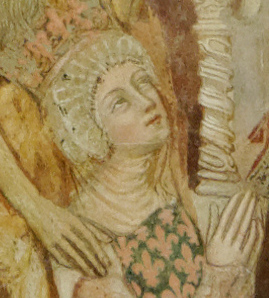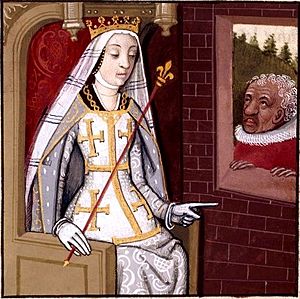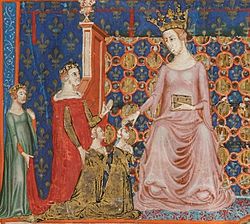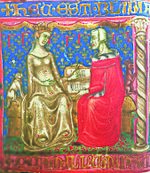Joanna I of Naples facts for kids
Quick facts for kids Joanna I |
|
|---|---|

Queen Joanna I, fresco by Niccolò di Tommaso (1360 circa)
|
|
| Queen of Naples Countess of Provence and Forcalquier |
|
| Reign | 20 January 1343 – 12 May 1382 |
| Predecessor | Robert |
| Successor | Charles III |
| Coronation | 28 August 1344 (alone) 27 May 1352 (with Louis I) |
| Co-Monarch | Louis I (1352 – 1362) |
| Born | December 1325 Naples, Kingdom of Naples |
| Died | 27 July 1382 (aged 56) Muro Lucano, Kingdom of Naples |
| Burial | Santa Chiara Church |
| Spouse |
Louis, Prince of Taranto
(m. 1347; died 1362)Otto, Duke of Brunswick-Grubenhagen
(m. 1376) |
| Issue |
|
| House | Anjou-Naples |
| Father | Charles, Duke of Calabria |
| Mother | Marie of Valois |
Joanna I (also known as Johanna I or Giovanna I in Italian) was a powerful queen who ruled the Kingdom of Naples, and was also the Countess of Provence and Forcalquier. She reigned from 1343 to 1382. Joanna was also the Princess of Achaea from 1373 to 1381.
Joanna was the oldest daughter of Charles, Duke of Calabria, and Marie of Valois. Her father died before her grandfather, King Robert, in 1328. Three years later, King Robert chose Joanna as his heir. He made his nobles promise loyalty to her.
To make Joanna's position stronger, King Robert arranged for her to marry his nephew, Andrew of Hungary. King Robert wanted Joanna to be his only heir. When he died in 1343, he named Joanna as the sole ruler. He also set up a group of advisors to help her rule until she turned 21.
Joanna's personal life caused many political problems. Her first husband, Andrew, died suddenly in 1345. This led to invasions by King Louis I of Hungary, who wanted to avenge his brother's death. Joanna married three more times. These marriages, and her choice to support one Pope over another during a big church split, weakened her power.
Joanna had no children who lived longer than she did. So, her heirs were the children of her sister, Maria. Joanna tried to secure her family's future by arranging a marriage for her niece, Margaret of Durazzo. Margaret married Charles of Durazzo. Charles later captured Joanna and ordered her death on July 27, 1382.
Contents
Early Life and Becoming Queen
Joanna was the oldest surviving child of Charles, Duke of Calabria. Her mother was Marie of Valois, who was the sister of King Philip VI of France. Historians believe Joanna was born in December 1325 or early 1328. Her father died in 1328, making Joanna the next in line to the throne after him.
After her father's death, her grandfather, King Robert, faced a problem. He had no sons left. Even though women could inherit the throne in Naples, it was unusual for a queen to rule alone. Also, the Neapolitan royal family was related to the French royal family, who had recently stopped women from becoming queens.
King Robert wanted to make sure his family would continue to rule. So, he named Joanna and her younger sister, Maria, as his heirs in 1330. Many nobles swore loyalty to Joanna.
King Charles I of Hungary also wanted a claim to Naples. He suggested a marriage between Joanna and one of his sons. The Pope supported this idea. Eventually, it was decided that Joanna would marry Charles I's younger son, Andrew.
After Joanna's mother died in 1332, her step-grandmother, Sancia of Majorca, helped raise Joanna and Maria. Their nurse, Philippa of Catania, also had a big influence on them. Joanna grew up in a cultured court. She learned to speak Latin, French, Italian, and Provençal.
In 1333, Joanna and Andrew were officially engaged. They were also given the titles of Duke and Duchess of Calabria. However, their marriage was not fully carried out for years. Andrew was seen as a foreigner by many in Naples. Joanna and her cousins often made fun of him.
King Robert wanted Joanna to be the sole ruler of Naples. In his will, he named her as his only heir. He did not order Andrew's coronation. This meant Andrew would not have a direct role in governing Naples. Robert also set up a group of advisors to help Joanna rule until she turned 21.
Joanna's Reign Begins
King Robert died on January 20, 1343. Joanna was 17 years old. Two days later, Andrew was made a knight, and their marriage was completed. However, they mostly kept separate lives. Joanna even stopped Andrew from entering her room without her permission. Andrew had little money of his own, and Joanna's advisors controlled his spending.
Many people did not like the idea of a group of advisors ruling. Joanna asked Pope Clement VI to make Andrew a king. She hoped this would help her rule sooner. The Pope did not agree.
Joanna's sister, Maria, secretly married Charles, Duke of Durazzo. This made Joanna very angry. She asked the Pope to cancel the marriage, but he refused. Joanna began to trust her own close friends and family more, like Philippa of Catania's son.
Andrew's mother, Queen Elizabeth of Poland, came to Naples to help her son. She wanted the Pope to crown Andrew as king. She brought a lot of money to gain support. Joanna met her wearing her crown to show she was the queen.
Queen Elizabeth tried to get Andrew crowned, but Joanna used delaying tactics. The Pope was worried about the chaos in Naples. He sent a special representative, Cardinal Aymery de Châlus, to govern the kingdom. Joanna tried to delay his arrival.
When the cardinal arrived, Joanna had to swear loyalty to the Pope in public, along with Andrew. The cardinal took over the government. However, Joanna and her officials often ignored his orders. She also refused to pay the yearly tribute to the Pope.
The Pope eventually recalled his representative. He declared that Joanna, now 18, was old enough to rule alone. In 1345, the Pope told Joanna's closest advisors not to get involved in politics. Joanna tried to make peace with Andrew, and she became pregnant.
Joanna's relationship with the Pope became difficult again. She started giving away royal lands, which angered him. The Pope threatened to remove her from the church if she continued. Joanna also left Andrew. Rumors spread that she was in love with Louis of Taranto.
The Pope decided to go ahead with Andrew's coronation. But a group of nobles plotted against Andrew. During a hunting trip in September 1345, Andrew was attacked and killed. Historians are divided on whether Joanna was involved in his death.
On December 25, 1345, Joanna gave birth to Andrew's son, Charles Martel. He was named Duke of Calabria and heir to the kingdom.
Joanna's Later Marriages and Challenges
Louis of Taranto as Co-Ruler
After Andrew's death, Joanna married Louis of Taranto in 1347. From 1349, all official documents were issued in both their names. Louis took control of military forts and had a strong influence. He was officially recognized as co-ruler by the Pope in 1352. Louis was crowned with Joanna in Naples.
Louis used a Hungarian attack to gain more power. He removed Joanna's supporters from court. Joanna and Louis had two daughters, Catherine and Françoise, but both died young.
In 1356, Louis and Joanna tried to take back Sicily. They entered Messina but were forced to leave after a naval defeat. Louis of Taranto became ill and died on May 25, 1362.
Joanna Rules Alone
Louis's death allowed Joanna to regain full control of her kingdom. She made popular decisions, like pardoning some people and appointing new officials.
In 1362, Joanna married for the third time to James IV. He was ten years younger than her. This marriage was also difficult. James had been imprisoned for many years, which affected his mental health. He also wanted to be involved in ruling, but their marriage contract said he could not.
Joanna became pregnant in 1365 but had a miscarriage. She never had another child. James left Naples in 1366 and tried to regain his own kingdom. He was captured and later ransomed by Joanna. He returned briefly but then left for good. He died in 1375.
Joanna had good relationships with the Popes during this time. She recovered some of her lands in Piedmont. In 1372, she officially accepted that Sicily was lost to her kingdom. Joanna was a fair and careful ruler. She supported local businesses and new industries. She also worked to reduce crime and promote peace.
Joanna's court was known for being very grand. She had a collection of exotic animals and servants from many different places. The writer Giovanni Boccaccio described her as "more renowned than other woman of her time for lineage, power, and character."
The Great Church Split and Joanna's Final Years
Since Joanna had no surviving children, she needed to choose an heir. In 1369, she arranged for her niece, Margaret of Durazzo, to marry her cousin, Charles of Durazzo. This marriage was meant to secure the succession.
However, Joanna later decided to weaken Charles's position. In 1375, she married for the fourth time to Otto, Duke of Brunswick-Grubenhagen. This marriage angered Charles of Durazzo, who then became friends with Joanna's enemy, King Louis I of Hungary.
During this time, a major split happened in the Christian church, called the Western Schism. Two Popes were elected: Urban VI in Rome and Clement VII in Avignon. After some thought, Joanna chose to support Clement VII.
Urban VI became angry and declared Joanna a heretic. He said her kingdom was lost and gave it to Charles of Durazzo. In response, Joanna adopted Louis I, Duke of Anjou, as her heir in 1380, replacing Charles of Durazzo.
Charles of Durazzo then invaded Naples with an army, mostly made up of Hungarians. Joanna's husband, Otto of Brunswick, tried to stop them but was defeated. Charles entered Naples and surrounded Joanna in her castle.
Joanna had no help and was forced to surrender in August 1381. She was imprisoned, first in Castel dell'Ovo and later in another castle.
A religious leader, Catherine of Siena, believed Joanna was wrong for supporting Clement VII. She wrote to Joanna, saying that by supporting the Avignon Pope, Joanna had lost her right to rule. Naples was legally under the Pope's authority in Rome.
Joanna's Death
Louis I of Anjou finally decided to help Joanna. He gathered a large army and marched towards Naples in 1382. However, by that time, Joanna was already dead.
Charles of Durazzo, fearing Louis's army, decided to move Joanna to another castle. On July 27, 1382, Joanna was killed at the Castle of Muro Lucano. She was 56 years old.
Charles claimed she died of natural causes, but other records say she was murdered. Her body was brought to Naples and shown to the public to prove she was dead. Because Urban VI had removed her from the church, Joanna could not be buried in sacred ground. Her body was put into a deep well at Santa Chiara Church.
Joanna's death led to many years of wars over who would rule Naples.
Joanna in Books and Art

- The famous writer Giovanni Boccaccio wrote about Joanna in his book De mulieribus claris (On Famous Women). Boccaccio wanted to show that Joanna was the rightful ruler of Naples. He wrote that she came from a noble family and inherited the kingdom fairly. Boccaccio admired Joanna's ability to rule. He said that Naples was a successful kingdom because Joanna was a strong leader.
- Alexandre Dumas, père wrote a story called Joan of Naples in his series Celebrated Crimes.
- There are also novels about her life, such as Queen of Night by Alan Savage and Napolyi Johanna by László Passuth.
Titles and Styles
Joanna's full title as queen was: Joanna, by the Grace of God, Queen of Jerusalem and of Sicily, Duchess of Apulia, Princess of Capua, and Countess of Provence, Forqualquier, and Piedmont.
See also
 In Spanish: Juana I de Nápoles para niños
In Spanish: Juana I de Nápoles para niños








